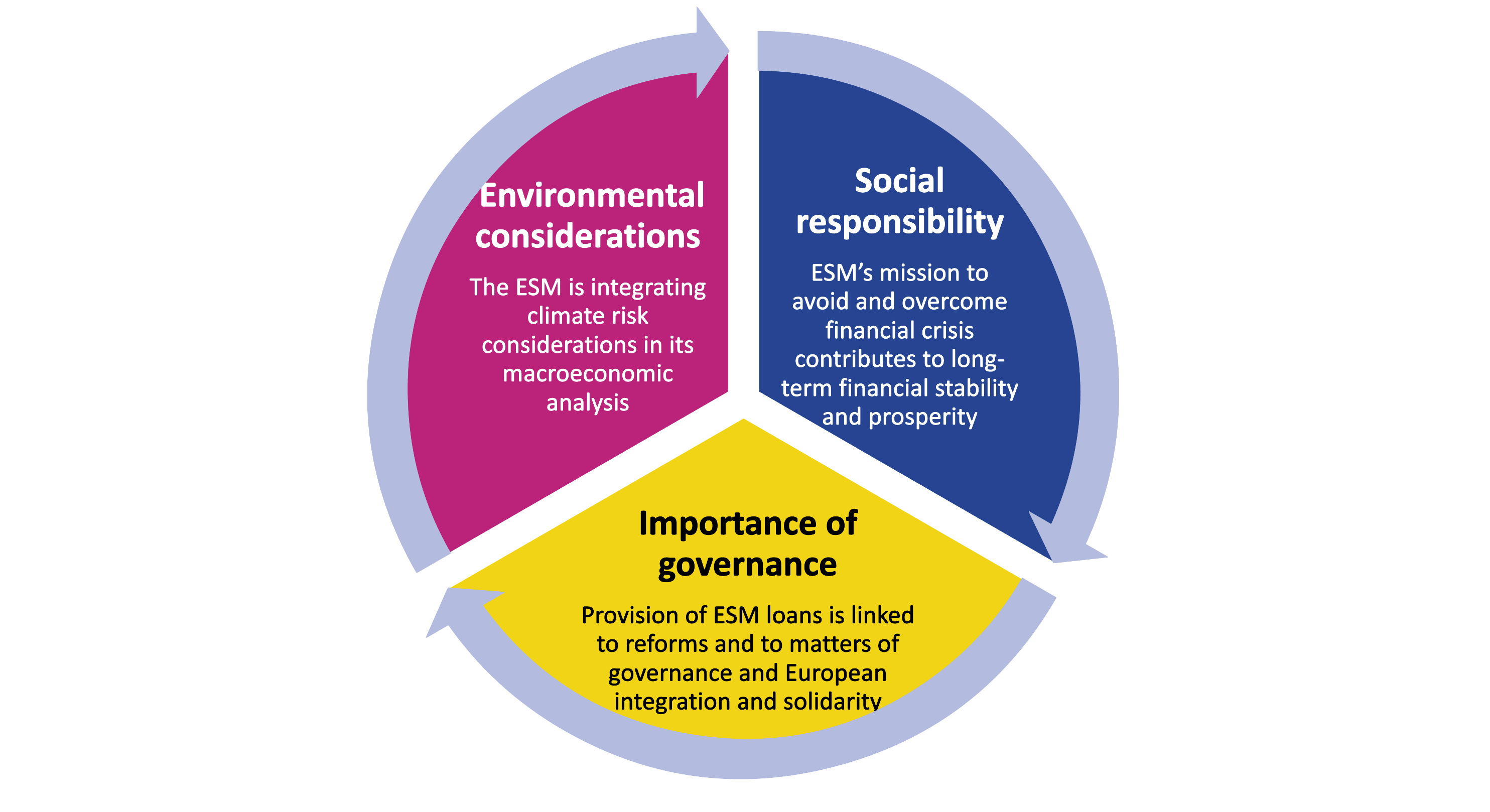ESM’s holistic approach to ESG and sustainable prosperity
The environmental, social, and governance (ESG) market has rapidly evolved over the last few years, with a myriad of bond products emerging from the market due to an ever-growing demand for sustainable assets. By March, ESG-themed bond issuance topped €3 trillion worldwide, making it a powerful asset class.
What had begun as the development of the green bond market was followed by a surge in social bond issuance in response to the pandemic crisis of 2020 and 2021. This accelerated the growth of the asset class. Most of this market growth has been driven by European public and corporate issuers and denominated in euros, which remains the currency of choice for ESG bonds and represents close to 50% of total ESG debt issued so far in 2023.
Such rapid growth in ESG assets has generated an intense focus on thematic or labelled bonds from investors who, until recently, focused their ESG requirements on these specific products.
But the introduction of regulatory disclosure requirements, as well as the development of new ESG rating and scoring methodologies, has encouraged investors to turn to a more holistic approach to ESG by taking a broader perspective and looking at the global sustainable strategy and disclosures of companies rather than just their portfolio of green assets. The ESM, particularly in light of the steep increase in issuance and the various products available, is determined to continue implementing such a holistic approach in its investment decisions or institutional actions as part of a global sustainable strategy.
Both the holistic approach and the success of sustainable projects matter to the ESM because they could help secure prosperity in the future and maintain financial stability, the mandate of the euro area’s firefighter.
ESG is still a fairly young buzzword. After the 1990s, it grew out of slogans like ethical investments and socially responsible investments. Back then, it involved screening out investments that were widely believed to be harmful to the planet. Today, it is more about promoting projects that do good.
This holistic approach relies on issuers actively managing and communicating an ESG strategy that includes, among other things, improving ESG ratings, reporting on overall impact, and developing institution-wide ESG internal policies.
For an investor, there are two main factors that have increased the appeal of the holistic approach:
- ESG ratings. As investors become more discerning in how they assess the ESG quality of investment opportunities, they develop their own methodologies to score potential ESG investments. This leads to further emphasis on the overall ESG profile as a key part of the analysis for all investments (conventional and ESG-labelled products). In fact, such analysis is very similar for both types of products, which generally starts with the analysis of the issuer’s strategy, its investment plan, and its governance structure.
- Regulation. Investors are influenced by the introduction of ESG regulatory requirements. For example, the Sustainable Finance Disclosure Regulation defines metrics that may help investors in the definition and classification of sustainable investments (the so-called principal adverse impact indicators). Sometimes, the use and interpretation of these indicators requires the application of the “do no significant harm” (DNSH) principle, a concept already introduced in the green taxonomy. This principle defines an investment as sustainable if neither the environmental nor the social objectives are significantly harmed. In this context, a holistic approach sustained by global ESG strategies can be very useful for investors in the application of the DNSH principle, where controversies or negative impacts can affect investors’ willingness to buy any kind of asset, regardless of the ESG label.
The ESM’s initial commitment to ESG
The ESM responded to the rapidly evolving requirements from investors by striving to implement ESG best practices within its operations. Since 2018, the ESM has deepened its ESG commitments, with special focus on the publication of its annual carbon footprint report, which analyses the emissions arising from the ESM’s corporate activities and internal operations.
On the investment side, the ESM started its support to this market in the early stages of green bond issuance as far back as 2014. Since then, the ESM has been a reliable investor in use-of-proceeds bonds, also known as labelled bonds, strengthening its commitment as a responsible investor. At the end of 2022, the ESM held €4.5 billion of these bonds, split nearly equally between social, green, and sustainable bonds. In 2020 the ESM signed the UN-backed Principles for Responsible Investment, deepening and broadening its overall commitments – particularly by engaging in a process to incorporate responsible criteria into its investment decisions. The first results were published in the ESM's 2022 Annual Report.
The ESM’s holistic approach
Following its initial commitments, the ESM recently named ESG as one of its institutional priorities and started to build its sustainable strategy. An ESG Strategic Steering group was established to coordinate the cross-divisional initiatives and provide guidance to a working group that facilitates interactions when working on ESG deliverables across the institution. The steering group also serves as an internal platform for discussion and collaboration of all ongoing and planned initiatives.
The outcome of this is a holistic strategy covering the three ESG pillars:
- Environmental. At institutional level, the ESM is deepening its analysis of the implications of climate change on financial stability and has created a strategic plan to integrate relevant ESG considerations into its macroeconomic analysis, risk management activities, reporting, and research. Internally, the ESM continues its efforts in reducing the carbon footprint arising from its internal operations.
- Social. Social responsibility is the cornerstone of the ESM’s mandate. Safeguarding financial stability enhances confidence, reduces contagion from vulnerable countries, and helps minimise social and human costs of potential financial or economic turmoil.
The holistic approach is also reflected in the ESM’s funding operations, which are influenced by the global ESG strategy. At the same time, the institution remains flexible and ready for the design of specific labelled programmes in case of future mandates that require so, as was the case with the ESM Social Bond Framework developed during the pandemic crisis. - Governance. The ESM has a robust governance framework in place that provides strong accountability and transparency, ensuring its activities are conducted in accordance with the highest standards of ethics and integrity. Furthermore, the provision of ESM financial assistance is linked to reform and is, therefore, naturally connected to matters of governance and European integration and solidarity.
ESG asset scoring
As a result of this holistic approach, the ESM has also focused on implementing issuer-based ESG scoring for its paid-in capital investments. In 2022, the ESM selected Moody’s Vigeo Eiris as its ESG rating provider, and when applying the ESG scores to the paid-in capital, the ESM obtained an ESG weighted average score of 73 out of 100 at the end of 2022, corresponding to Moody’s advanced category.
Such a scoring approach for the paid-in capital can be extended to the ESM total assets in the balance sheet, including the outstanding loans to euro area member states (€60 billion to Greece, €20 billion to Spain, and €6 billion to Cyprus), and excluding cash deposits. Applying the ESG sovereign scores from Moody’s for these countries, the ESM loan portfolio obtained a weighted average score of 72 out of 100, placing the ESM in the Moody’s advanced category.
The guidance of the ESM’s holistic approach also resulted this year in the publication of its inaugural ESG Summary Report. A one-stop codified document that presents all of ESM’s initiatives and that should help to better inform ESG analysts on the institution’s actions.
But when it comes to adherence to ESG standards, the efforts of institutions such as the ESM are not just about numbers, ticking boxes, nor satisfying regulators. They are about the public sector leading by example and encouraging private enterprises and households to make positive changes, large and small. Hence, they are about contributing to a more sustainable economy and safer world for future generations.
Acknowledgements
The author would like to thank Kalin Anev Janse, Raquel Calero, Sarah Fouqueray-Carrick, Carlos Martins, George Matlock, and Silke Weiss for their valuable comments and contributions.
Further reading
About the ESM blog: The blog is a forum for the views of the European Stability Mechanism (ESM) staff and officials on economic, financial and policy issues of the day. The views expressed are those of the author(s) and do not necessarily represent the views of the ESM and its Board of Governors, Board of Directors or the Management Board.
Author


